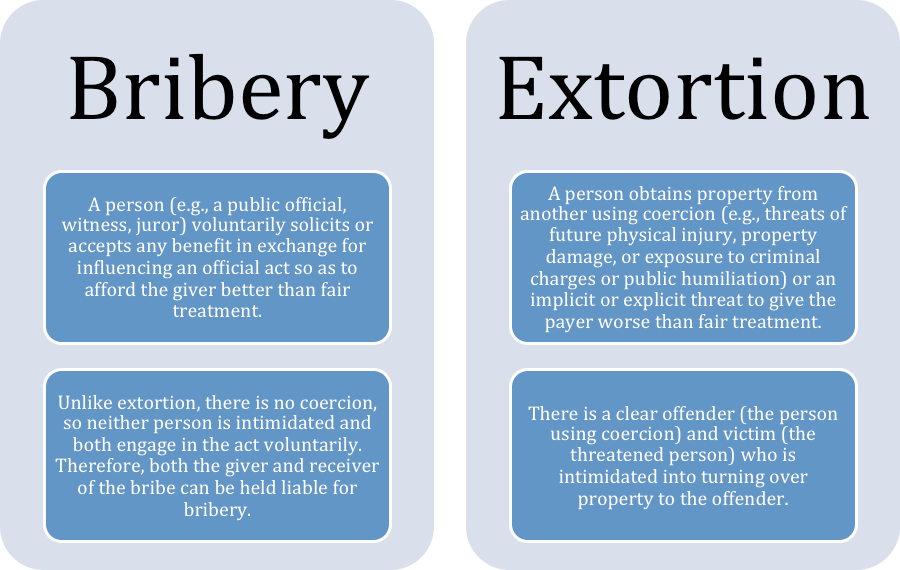Article 15 of the Convention against Corruption defines bribery of national public officials as both the promise, offering or giving of an undue advantage and the solicitation or acceptance of an undue advantage by a national public official. Similarly, article 16 deals with bribery of foreign public officials and officials of public international organizations.
The legal distinction between bribery and extortion is not straightforward, it varies between jurisdictions and a person can be guilty of both in many instances. The debate over the bribery-extortion distinction has centred on the second type of extortion, namely the extortion under colour of official right. There is a degree of overlap between the two concepts and "extortion 'under colour of official right' equals the knowing receipt of bribes" (United States v. Holzer, 1988). Both offences involve the exchange of money, property, or services, but the manner in which the exchange occurs and the parties involved often vary depending upon the nature of the crime.
In extortion, the receiver is making a threat towards the extorted party, threatening to perform a certain action that will harm the extorted party unless the extorted party gives the receiver whatever the receiver requests. On the other hand, in cases of bribery, the bribed party will do something in favour of the bribing party.
Bribery relates to a corrupt benefit given or received to influence official action so as to afford the giver better than fair treatment. Both the person giving and the recipient are guilty of bribery. On the other hand, coercive extortion by a public official is the seeking or receiving of a corrupt benefit paid under an implicit or explicit threat to give the payer worse than fair treatment or to make the payer worse off. The payee is guilty of extortion; the payer is the victim of extortion.
In other words, bribery and extortion present several significant commonalities and differences, which are illustrated in Figure 4.1 below.
Organized criminal groups commonly use bribery to protect their illicit activities. For instance, members of organized criminal groups may do illicit favours or pay judges, jurors, police or other public officials in exchange for them to "look the other way". Extortion characterizes the infiltration of legitimate business when organized criminal groups try to force payments from individuals or businesses using threats to avoid worse than fair treatment.

The line between bribery and extortion is rather blurred when a public official expects a bribe for an action they are paid to carry out. Surveys in different countries have found that businesses and citizens often have little choice but to pay what is asked (UNODC, 2013; UNODC, 2017). This situation makes it difficult to assess the true voluntariness of the exchange.
|
Examples of bribery from the Western Balkans and Nigeria WESTERN BALKANS Roughly, one in ten businesses (10.2 percent) that had contact with a public official in the 12 months prior to the survey paid a bribe to a public official. (UNODC, 2013) NIGERIA Most bribes are solicited by public officials in return for public services that are their duty to deliver, indicating that those officials have little fear of being sanctioned. This suggests that in such cases bribery is not simply seen as a kind of administrative lubricant to smoothen the bureaucratic process, but rather as a scheme to extort money or other types of bribe from the citizen requesting the public service (UNODC, 2017). |